Chicken Scarpariello
Chicken Scarpariello, or “shoemaker’s chicken,” is a bold, rustic dish that bridges Italian and Italian-American tradition in one hearty skillet. Anchored by golden seared chicken thighs and sweet Italian sausage, this dish simmers in a tangy, aromatic sauce built on white wine, pickled Peppadew peppers, and rosemary.
It’s the kind of meal that fills the kitchen with warmth and the plate with contrast—savory meats, briny sweetness, and sharp vinegar playing together in harmony.
What sets this dish apart is its balance: the richness of the chicken and sausage is cut perfectly by the acidity of the wine and vinegar, while the sweetness of caramelized onions and peppers gives it complexity and depth.
Finished with crisp roasted potatoes and a scatter of fresh parsley, Chicken Scarpariello is a dish that’s both comforting and energetic—soulful enough for Sunday supper, yet vibrant enough to impress at the table.
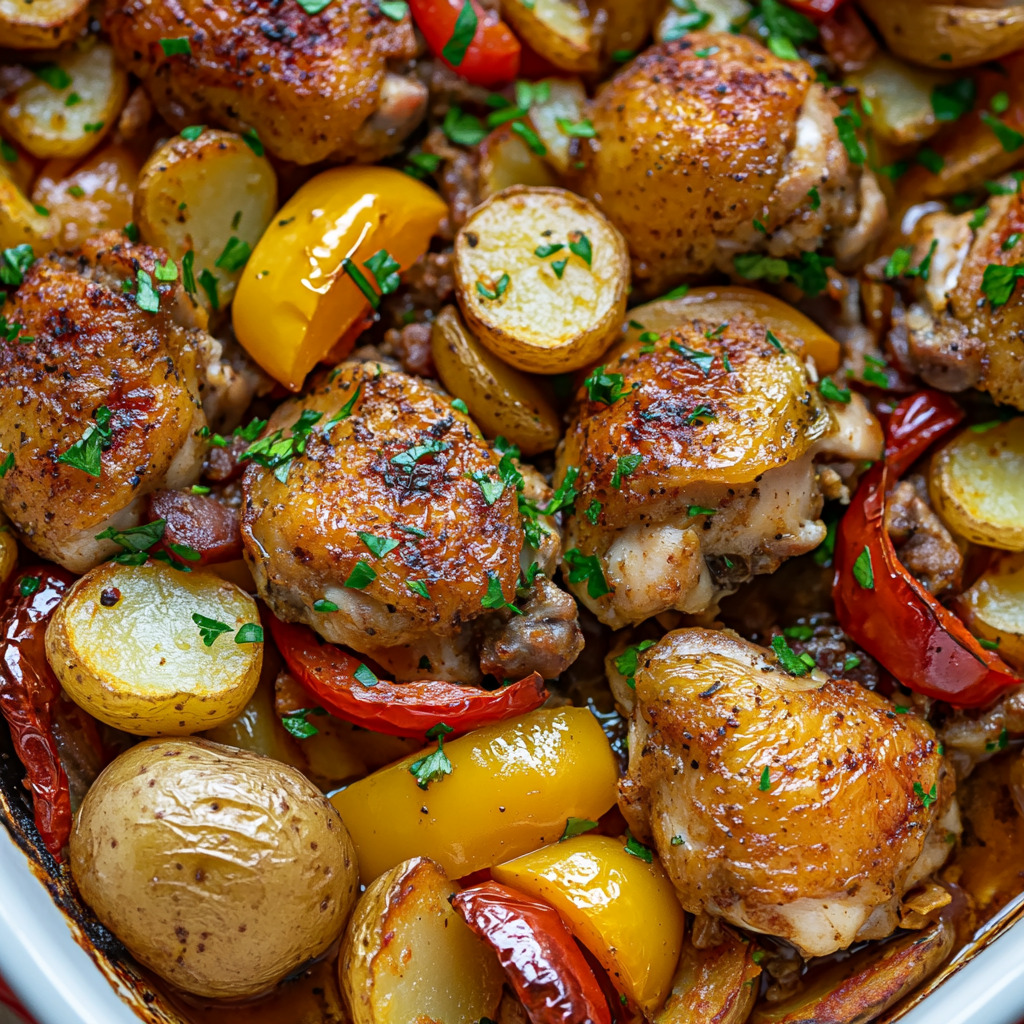
Why People Will Love This Chicken Scarpariello Recipe:
Bold, Balanced Flavor Profile:
The dish masterfully combines savory seared meats with the bright acidity of white wine and vinegar, creating a rich yet vibrant sauce that keeps every bite exciting.
Rustic Comfort Meets Restaurant Elegance:
It has all the warmth of a homemade, slow-simmered skillet meal but with layers of flavor and texture that feel elevated—perfect for casual dinners or entertaining guests.
Sweet & Spicy Contrast:
The inclusion of sweet Italian sausage and tangy Peppadew peppers delivers a sweet-heat contrast that surprises and delights, cutting through the richness of the meat.
Complex Without Being Complicated:
Though the flavors are deeply layered, the technique is straightforward—making it accessible for home cooks who want to impress without stress.
A Complete, Satisfying Meal:
With golden roasted potatoes, tender chicken, and flavorful sausage, this is a hearty all-in-one dish that needs no sides—just a crusty piece of bread to mop up the sauce.
Deeply Aromatic and Visually Inviting:
From the sizzle of the skillet to the rosemary-infused steam rising from the oven, it’s a dish that engages every sense and brings the kitchen to life.
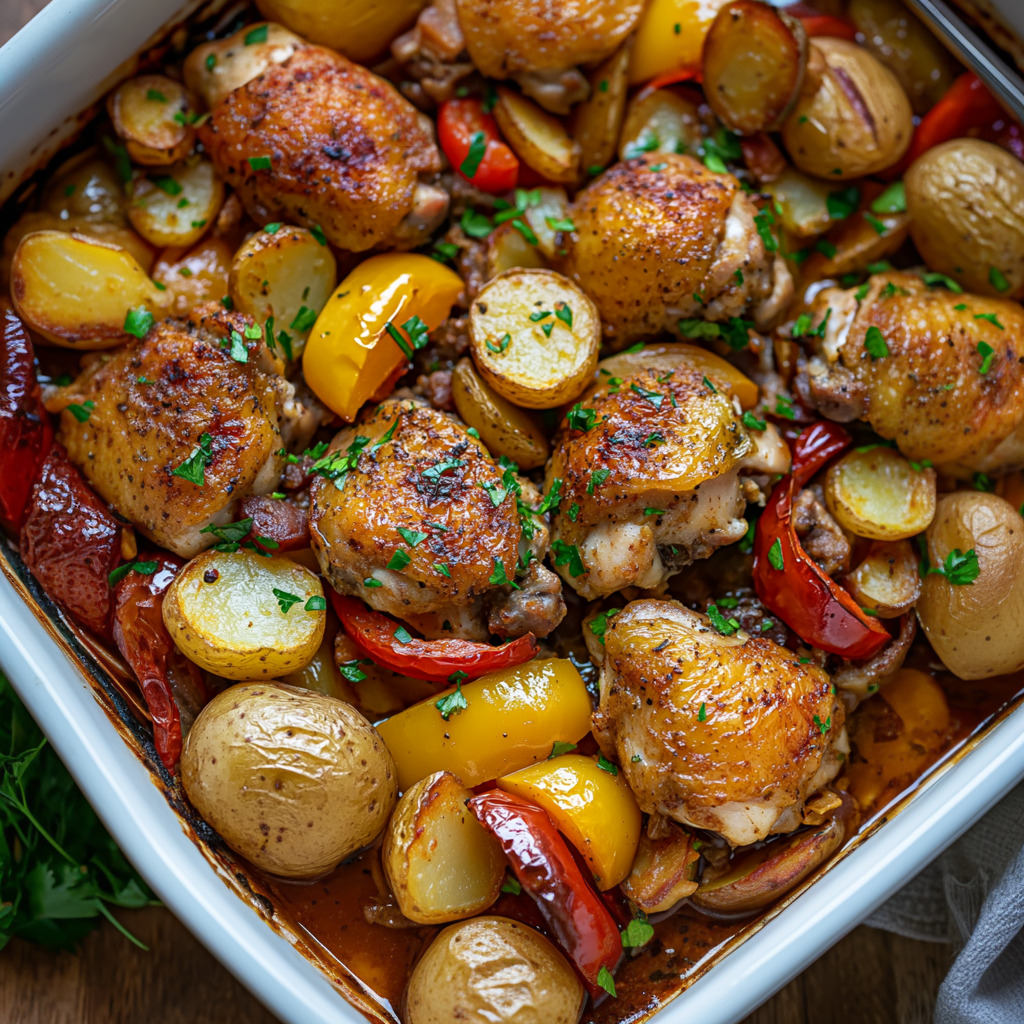
Key Ingredients:
Bone-In, Skin-On Chicken Thighs:
These deliver rich, juicy flavor and a beautiful golden sear. The skin crisps while roasting, locking in moisture, and the bones add depth to the sauce during braising.
Sweet Italian Sausage:
Slightly sweet and seasoned with fennel, this sausage provides savory fat and contrast to the tangy sauce. It’s a classic Italian-American addition that enriches the dish’s rustic roots.
Peppadew Peppers in Brine:
These pickled sweet-spicy peppers are the soul of the sauce—bright, tangy, and subtly hot. They cut through the richness and give Chicken Scarpariello its signature zip.
White Wine & White Wine Vinegar:
A duo of acidity—wine for complexity, vinegar for sharpness. Together, they balance the fatty meats and caramelized onions, giving the sauce its sharp, savory backbone.
Fresh Rosemary:
Herbaceous and piney, rosemary adds depth and a rustic aroma that elevates the entire dish. Its presence in the sauce gives it a subtle earthiness without overpowering the other elements.
Onions, Bell Peppers & Garlic:
The aromatic base—sautéed until golden and sweet—anchors the sauce with savory warmth. Their natural sugars mellow out the acidity and bring cohesion to the dish.
Fingerling Potatoes:
Roasted until tender and crisp, these serve as the perfect starchy companion, soaking up the flavorful juices and grounding the plate with rustic heartiness.

Expert Tips:
Sear for Flavor, Not Full Cooking:
When searing the chicken and sausage, focus on building a deep, golden crust—not fully cooking them. The fond (browned bits) left behind is essential for developing a rich, flavorful sauce.
Use Bone-In, Skin-On Chicken for Depth:
Boneless cuts may save time, but they lack the flavor and texture bone-in thighs provide. The bones enrich the sauce during braising, and the skin helps lock in moisture while crisping beautifully under high oven heat.
Deglaze Thoroughly After Sautéing Aromatics:
After cooking the onions, garlic, and peppers, deglaze with white wine and scrape the pan bottom thoroughly. This releases caramelized fond into the sauce, giving it its signature savory backbone.
Balance the Vinegar Carefully:
White wine vinegar adds necessary brightness, but too much can overwhelm. Always taste the sauce after reduction—if it’s too sharp, add a small splash of chicken broth or a pat of butter to round it out.
Let the Sauce Reduce to Concentrate Flavor:
Before returning the chicken and sausage to the pan, simmer the wine, vinegar, and broth mixture for a few minutes. This concentrates the flavor and ensures the sauce isn’t too thin when it finishes in the oven.
Use a High Heat Oven Finish for Texture Contrast:
Roasting the dish uncovered at 450°F crisps the chicken skin while thickening the sauce and caramelizing the top layer of aromatics. This creates a contrast of crispy edges and juicy interiors—crucial for textural depth.
Rest the Dish Before Serving:
After removing the skillet from the oven, let it sit for 5–10 minutes before serving. This helps the sauce settle and the proteins reabsorb juices, ensuring a more balanced and flavorful bite.
Serve Potatoes on the Side, Not in the Skillet:
Roasting the fingerlings separately keeps them crisp. If added to the skillet too early, they’ll absorb excess moisture and become soft. Serve them alongside or under the chicken to soak up the sauce without losing their texture.
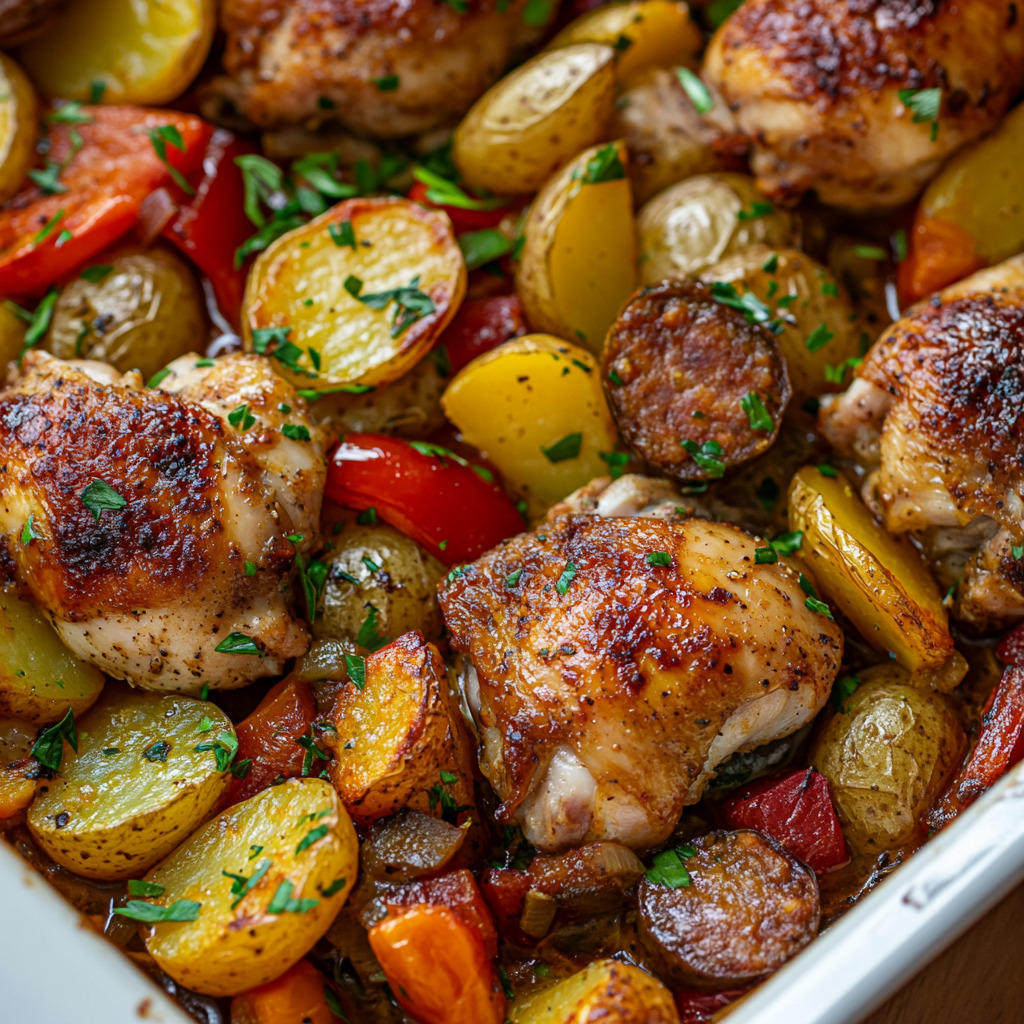
Chicken Scarpariello
Ingredients:
1½ lb. fingerling potatoes, halved lengthwise
6 Tbsp. extra-virgin olive oil, divided
Kosher salt, freshly ground black pepper
3 links sweet Italian sausage
6 skin-on, bone-in chicken thighs
2 large onions, chopped
½ large red bell pepper, chopped
6 garlic cloves, finely grated
1 cup dry white wine
1 cup low-sodium chicken broth
½ cup chopped hot, sweet pickled Peppadew peppers in brine, drained
¼ cup white wine vinegar
3 sprigs rosemary
Chopped parsley (for serving)
Instructions
Step 1: Roast the Potatoes
Preheat your oven to 450°F and position the oven racks in the upper and lower thirds.
On a rimmed baking sheet, toss the halved fingerling potatoes with 3 tablespoons of olive oil. Season generously with salt and pepper, then place them cut side down.
Roast on the lower oven rack for 20–30 minutes, or until the potatoes are golden and fork-tender. Set aside.
Step 2: Brown the Sausage
While the potatoes roast, heat the remaining 3 tablespoons of olive oil in a large oven-safe skillet over medium-high heat.
Add the sausage links and cook, turning occasionally, until browned on all sides (about 6–8 minutes). They won’t be fully cooked yet. Transfer to a plate.
Step 3: Sear the Chicken
Season the chicken thighs on both sides with salt and pepper.
In the same skillet, sear the chicken skin-side down first, turning occasionally, until golden on both sides (8–10 minutes total). They’ll finish cooking in the oven. Transfer them to the plate with the sausage.
Step 4: Build the Sauce
In the same skillet, add the chopped onions, red bell pepper, and grated garlic. Sauté over medium-high heat, stirring often and scraping up any browned bits, until soft and just beginning to caramelize (10–12 minutes).
Pour in the white wine and cook until it’s reduced and the alcohol aroma is gone, about 8 minutes.
Stir in the chicken broth, chopped Peppadew peppers, white wine vinegar, and rosemary sprigs. Bring to a boil and let it simmer for 5 minutes to concentrate the flavor.
Step 5: Finish in the Oven
Nestle the chicken thighs into the sauce, skin side up, then place the skillet on the upper oven rack. Roast for 10 minutes.
Add the browned sausages back into the skillet, tucking them into the sauce. Continue roasting for another 5–10 minutes, or until the chicken reaches 165°F at the thickest point.
Step 6: Serve
Remove from the oven, sprinkle with chopped parsley, and serve hot with the roasted potatoes on the side.
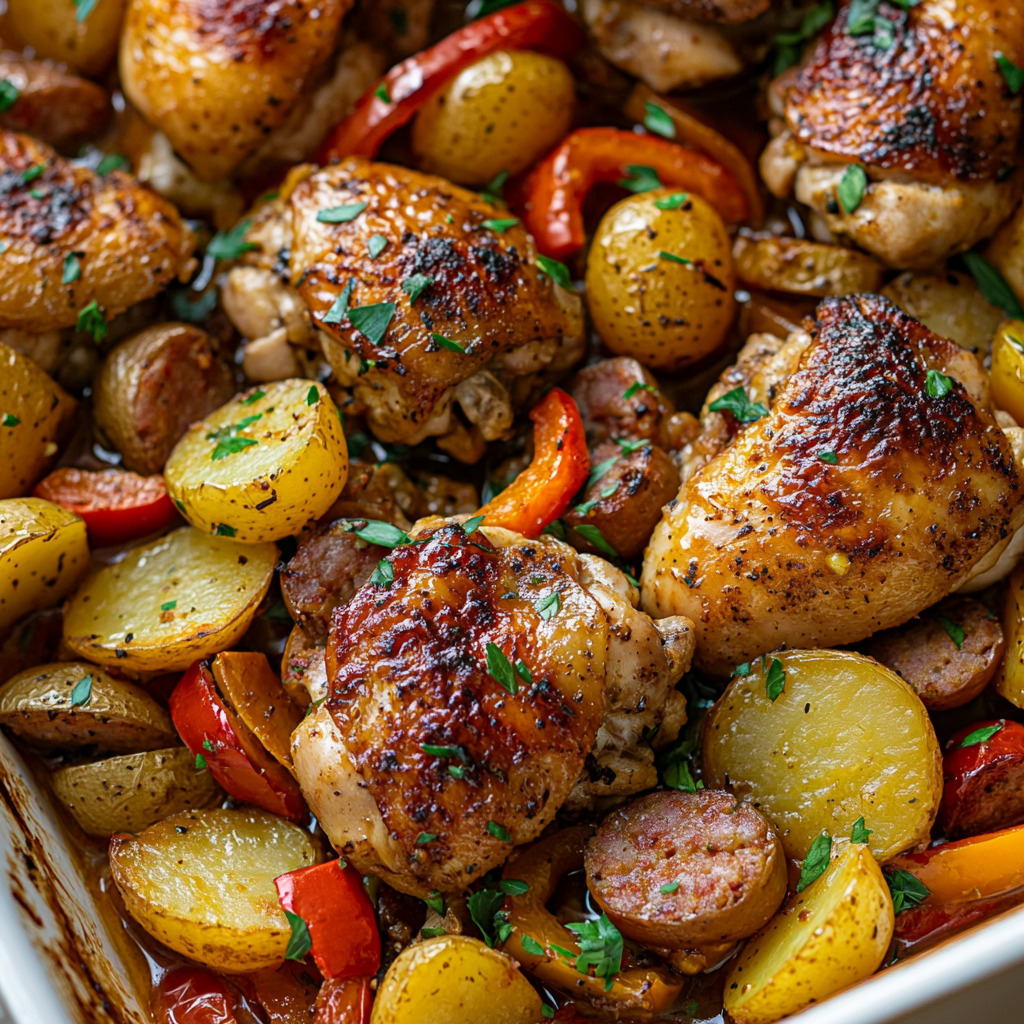
Important Notes When Making Chicken Scarpariello
This Dish is All About Flavor Contrast:
Chicken Scarpariello succeeds because of the tension between rich and acidic, sweet and spicy, crisp and tender. Don’t shy away from the vinegar, wine, or pickled peppers—they’re essential to cutting through the fattiness of the chicken and sausage.
Peppadew Peppers Are Key to Its Identity:
The pickled Peppadews (or any sweet-hot pickled pepper) are not a garnish—they’re a defining ingredient. Their tangy, slightly sweet heat gives the sauce its characteristic bite. Without them, the dish lacks dimension.
Layering Flavors is Non-Negotiable:
Each step—searing meat, sautéing aromatics, deglazing with wine, reducing the sauce—is there to build a foundation of depth. Rushing or skipping one will flatten the overall experience.
Oven Roasting Enhances Both Texture and Integration:
Finishing the dish in a hot oven allows the chicken to finish cooking gently, the sausage to fully integrate into the sauce, and the liquid to reduce into a glaze-like consistency that coats each ingredient beautifully.
Potatoes Should Be Crisp and Separate:
Roasting the fingerling potatoes separately allows them to keep their crispy edges and tender interiors. This keeps them from turning soggy and preserves a contrast of textures on the plate.
Don’t Overcrowd the Pan:
If your skillet is too small, the chicken will steam instead of sear. Work in batches as needed—browning meat properly is essential for developing flavor and texture.
Wine Quality Affects the Sauce:
Use a dry white wine you’d drink (like Sauvignon Blanc or Pinot Grigio). Poor-quality or overly sweet wines will compromise the acidity and depth the sauce needs.
This Dish Improves With Resting:
Once removed from the oven, a 5–10 minute rest allows the sauce to thicken naturally and the proteins to relax, making it easier to serve and more flavorful when plated.
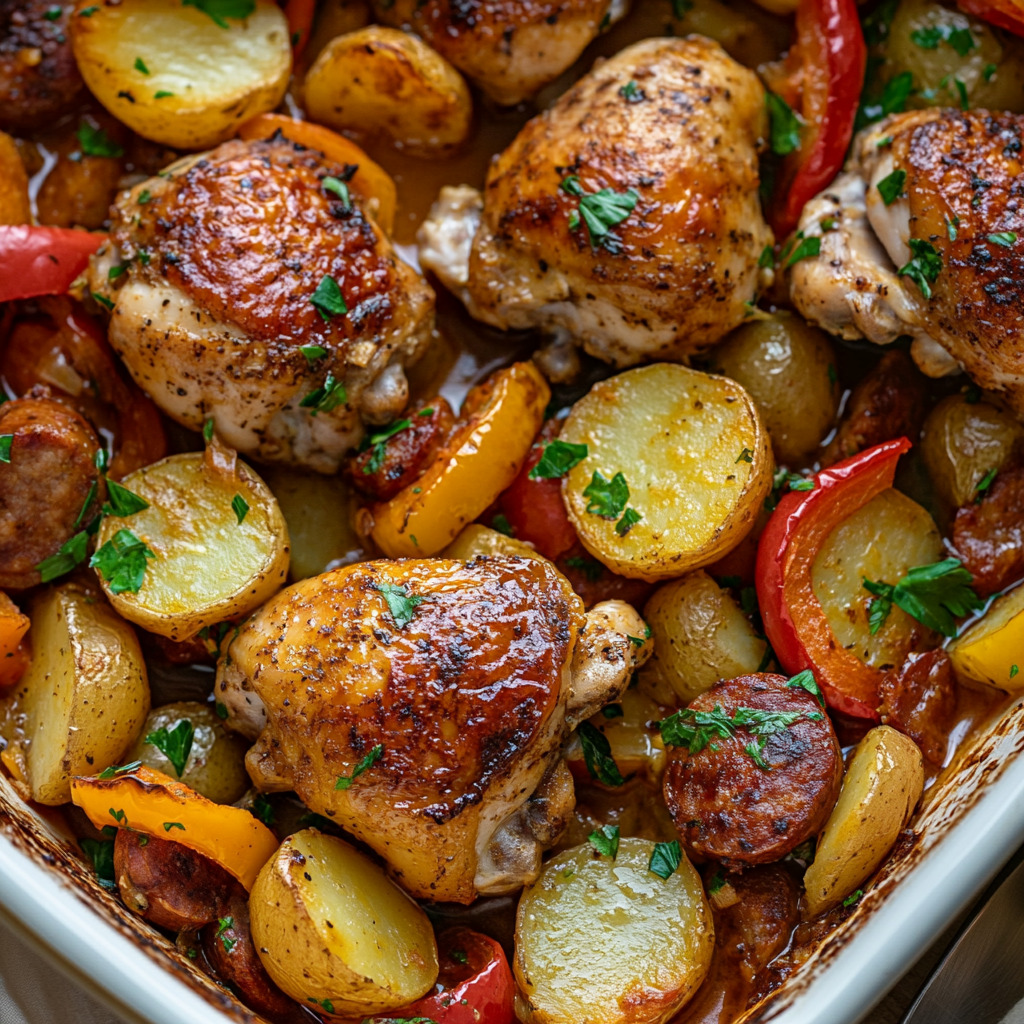
How to Enjoy Chicken Scarpariello After Cooking
Let It Rest Before Serving:
Once out of the oven, let the skillet rest for 5–10 minutes. This gives the sauce time to settle and the meat to reabsorb juices, resulting in more flavorful, tender bites.
Serve With the Roasted Potatoes on the Side:
Plate the crispy fingerling potatoes alongside the chicken and sausage—not underneath—so they retain their texture. Spoon the tangy, peppery sauce over the top or serve it on the side for dipping.
Highlight Each Bite:
Each forkful should capture contrast—crispy chicken skin, juicy sausage, silky onions, and the sweet heat of the Peppadew peppers. Don’t rush through it—this dish rewards slow savoring.
Pair With Bread or Polenta:
For a richer meal, serve with crusty bread to mop up the sauce or creamy polenta as a soft, buttery base that absorbs the tangy, herbaceous broth beautifully.
Add a Bright Finishing Touch:
Just before serving, add a sprinkle of fresh chopped parsley or a squeeze of lemon juice. This brightens the entire dish and balances the richness of the meats and sauce.
Enjoy With the Right Drink:
Pair with a dry white wine (like Pinot Grigio or Vermentino) to complement the vinegar and wine in the sauce, or a light, citrus-forward beer for a casual pairing.
Leftovers? Even Better:
The next day, the sauce deepens. Reheat gently in a skillet or oven, and use leftover chicken in sandwiches, grain bowls, or served over pasta for a delicious second act.

Nutrition Information:
Per Serving of Chicken Scarpariello.
Assuming the recipe yields 6 servings and includes chicken thighs, Italian sausage, potatoes, and sauce:
Calories: 525 kcal | Total Fat: 33.2 g | Saturated Fat: 9.4 g | Monounsaturated Fat: 16.1 g | Polyunsaturated Fat: 3.5 g
Cholesterol: 145 mg | Sodium: 620–750 mg (depending on sausage and added salt)
Total Carbohydrates: 22.6 g | Dietary Fiber: 3.2 g | Sugars: 4.1 g | Protein: 33.8 g
Notes:
Includes 1 chicken thigh and ½ sausage link per serving, roasted potatoes, and sauce components (onion, garlic, wine, vinegar, peppers).
Sodium varies depending on the salt content in the sausage and broth.
To lighten the dish, you can use skinless chicken thighs and reduce oil or sausage portions.
Frequently Asked Questions:
Can I use boneless, skinless chicken instead of bone-in thighs?
Yes, but with some trade-offs. Boneless, skinless chicken cooks faster and is easier to eat, but it won’t deliver the same depth of flavor or rich, crispy texture that bone-in, skin-on thighs offer.
If using boneless cuts, reduce the oven time slightly and consider searing in butter to add richness.
What can I substitute for Peppadew peppers if I can’t find them?
You can substitute with mild pickled cherry peppers, banana peppers, or a combination of roasted red peppers and a splash of pickle brine.
The key is to preserve the balance of sweet heat and acidity that defines the dish.
Can I make this dish ahead of time?
Absolutely. Chicken Scarpariello holds up beautifully.
Make it a day in advance, cool completely, and store in the refrigerator.
Reheat gently in the oven or on the stovetop with a splash of chicken broth to refresh the sauce and keep the meat juicy.
Is white wine essential to the sauce?
Yes—dry white wine adds acidity and complexity that deepen the sauce.
If needed, you can substitute with low-sodium chicken broth + a splash of lemon juice or white wine vinegar, but the flavor will be slightly less layered.
Can I add vegetables to make it a one-pan meal?
Definitely! While the fingerling potatoes are cooked separately for crispness, you can add mushrooms, fennel, or green beans to the skillet when the sausage goes back in.
Just avoid overloading the pan, as too much moisture may prevent proper roasting and browning.
Why do I partially cook the sausage and chicken before baking?
Searing the sausage and chicken first develops browning (Maillard reaction), which builds a deep, savory base for the sauce.
Partial cooking also renders excess fat and ensures the meats finish cooking gently in the oven without drying out.
Should I deglaze the skillet after sautéing the onions and garlic?
Yes—deglazing with white wine is crucial. It lifts the flavorful browned bits (fond) from the bottom of the pan into the sauce, adding richness and depth.
Let the wine reduce until the alcohol aroma fades and the liquid thickens slightly.
How do I know when the sauce is reduced enough before baking?
After adding wine, broth, vinegar, and peppers, simmer the sauce until it slightly thickens and clings to a spoon—about 5 minutes.
You want enough reduction that the sauce intensifies in flavor, but still plenty of liquid to braise the chicken.
Why are the potatoes roasted separately and not in the skillet with the chicken?
Roasting the fingerling potatoes separately allows them to develop crispy, golden edges. If cooked in the sauce, they’d become soft and lose their texture. Serving them on the side preserves contrast—crisp potatoes meet juicy chicken and tangy sauce.
What oven rack position is best for finishing the dish?
Use the upper rack when transferring the skillet to the oven. This exposes the chicken skin and sausage to more direct heat, helping to crisp the skin and finish caramelizing the sauce. It also ensures a well-browned, flavorful top layer.